| Article ID | Journal | Published Year | Pages | File Type |
|---|---|---|---|---|
| 11020811 | Applied Thermal Engineering | 2019 | 11 Pages |
Abstract
The use of liquid pistons is a promising approach for attaining efficient near-isothermal compression. One of the key factors affecting the efficiency of a liquid piston compressor is heat transfer. Understanding the heat transfer mechanism during compression is crucial for the design and development of an efficient liquid piston compressor. In this paper, heat transfer in the liquid piston compressor is studied experimentally for air compression. An analytical model is presented based on a thermal resistance circuit. Experiments are performed using compression chambers of different materials for a compression ratio of 2.05-2.35 with various stroke times of compression. It is observed that the rate of heat transfer increases with faster stroke time of compression. However, a faster compression process requires a higher compression work and results in a higher air temperature. The convective heat transfer coefficient of air decreases rapidly as compression proceeds and approaches a steady value towards the end of compression. Thermal resistance analysis for compression with different chamber materials indicates that convective thermal resistance of air has a significant contribution in the total thermal resistance. During the initial phase of compression, the high conductivity of the chamber material helps improve the overall heat transfer coefficient; however, it has a marginal effect during the later phase of compression. An isothermal compression efficiency of 84-86% is observed with the liquid piston.
Keywords
Related Topics
Physical Sciences and Engineering
Chemical Engineering
Fluid Flow and Transfer Processes
Authors
Vikram C. Patil, Pinaki Acharya, Paul I. Ro,
